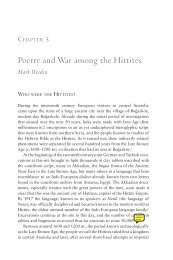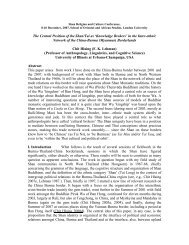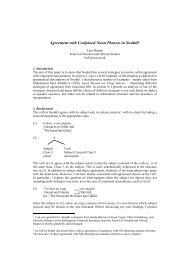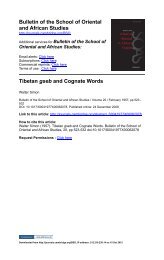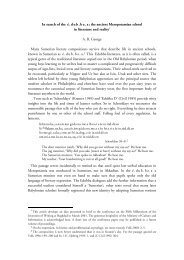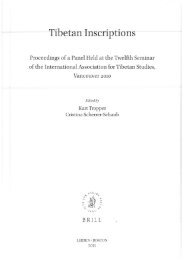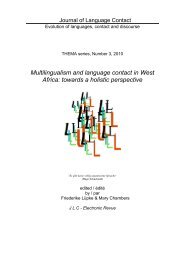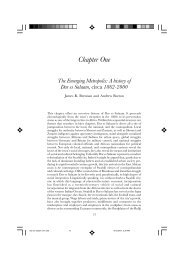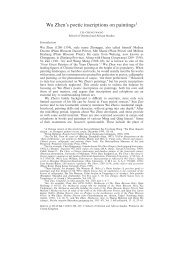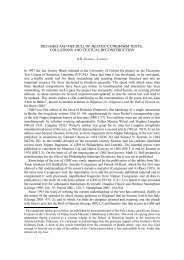Download (316Kb) - SOAS Research Online - The School of ...
Download (316Kb) - SOAS Research Online - The School of ...
Download (316Kb) - SOAS Research Online - The School of ...
Create successful ePaper yourself
Turn your PDF publications into a flip-book with our unique Google optimized e-Paper software.
254 almut hintze<br />
<strong>The</strong> perfect participle sam. vivyānáh. ‘having cloaked himself’ describes the trick<br />
whichIndrausedt<strong>of</strong>rightenVrtra. More details are found in RV 2.30.3:<br />
˚<br />
RV 2.30.3<br />
ūrdhvó hyásthād ádhy antáriks.é ’dhā vrtr<br />
´āya prá vadhám. jabhāra /<br />
míham. vásāna úpa h´īm ádudrot tigm ´āyudho<br />
˚<br />
ajayac chátrum índrah. //<br />
For he stood upright in the sky and thrust his murderous-weapon at Vrtra. En-<br />
˚<br />
veloping himself in a cloud he had run up to him. Having a sharp weapon, Indra<br />
defeated the enemy.<br />
Geldner, Rig-Veda I 313 interprets míham. vásānah. ‘enveloping himself in a<br />
cloud’ as referring to a ploy by Vrtra.<br />
However, apart from the awkward change<br />
<strong>of</strong> subject that this involves, RV<br />
˚<br />
5.29.4 sam. vivyānáh. confirms that it was Indra<br />
who was cloaked in a cloud while approaching the serpent in order to slay it. It<br />
is in this situation that the verb apa-gur occurs, immediately preceding Indra’s<br />
action <strong>of</strong> ‘slaying’ (han) the serpent.<br />
In any case, the passages quoted suggest that Indra employed a physical trick<br />
rather than a verbal one – as would be implied if apa-gur meant ‘to revile, abuse’<br />
– in the situation immediately preceding the act <strong>of</strong> slaying. Moreover, none <strong>of</strong><br />
the innumerable allusions in the RV to his great feat mentions that the god made<br />
an insulting speech before slaying the serpent. In its two Rigvedic attestations<br />
(RV 5.29.4 and 5.32.6), apa-gur occurs as an absolutive and a participle respectively,<br />
without object but qualifying the verb han in both instances. <strong>The</strong> syntactic<br />
context suggests that the action denoted by apa-gur immediately precedes, and<br />
forms part <strong>of</strong>, that expressed by the verb han.<br />
Not only in the Rigveda but also in Vedic Prose forms <strong>of</strong> apa-gur occur in the<br />
textual vicinity <strong>of</strong> the verb han ‘to slay’. From the Taittirīya Sa ˙mhitā onwards,<br />
forms <strong>of</strong> gur with prefixes apa, ava and ud appear particularly in legal contexts<br />
where apa-gur denotes an action immediately preceding a physical attack. It<br />
describes the first <strong>of</strong> three stages by which one person inflicts bodily injury on<br />
another with a weapon. <strong>The</strong> verbs characterizing the different stages are ápa-gur<br />
for the one before the attack, ní-han ‘to strike down’ for the second stage referring<br />
to the blow with a weapon, and finally lohitam. kr ‘to shed blood’, describing the<br />
effects <strong>of</strong> the blow.<br />
˚ 25<br />
A comparable distinction is also found in Zoroastrian law where special terms for<br />
various <strong>of</strong>fences, defined in Vd 4.17-43, N 42 and FiO 25b (= Klingenschmitt,<br />
FiO § 699-704), form part <strong>of</strong> its legal terminology. While there are some differences<br />
between the lists <strong>of</strong> the Videvdad and that <strong>of</strong> the Farhang-ī ōīm, the latter<br />
enumerates six <strong>of</strong>fences in order <strong>of</strong> increasing gravity. <strong>The</strong> Middle Persian terms<br />
are āgrift, ōiriˇst, arduˇs, xwar, bāzā-zaniˇsnīh and yād. All concern physical attack<br />
and any possible injury resulting therefrom. <strong>The</strong> mildest one, āgrift (’glpt,<br />
25 <strong>The</strong> relevant passages are quoted by Oertel, 1931, 287 f.; Burrow 1957 b, 9-11; Schaefer,<br />
Intensivum 117 f.



